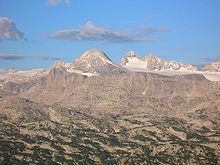Limestone plateau

The limestone plateau is a common landform in regions whose geology is characterized by limestone .
To carbonate rocks such as lime and dolomite, the forces of erosion attack primarily as a solvent and carbon dioxide decomposition to thereby numerous fissures and water-bearing columns are formed. This leads to a water balance that is v. a. runs underground while the surface of many areas remains roughly horizontal. Exceptions to this can only be found in geologically young orrogens ( mountain formations ). But even here there can be extensive plateau landscapes, for example in the Dachstein massif (Upper Austria).
Depending on how the carbonates were formed, limestone plateaus often show various types of fossilization or a special form of small forms - such as caves and karst phenomena . The precipitation of biogenic limestones and similar sediments with a high CaCO 3 content can also be shaping.
Limestone plateaus can be found in many large regions of the world - naturally most often on the edge of or near seas or earlier seas. They occur as plateaus on all continents, as karst landscapes because of the climatic influences, especially in the Mediterranean Sea or in China and Southeast Asia . In Central Europe , some regions in the Northern and Southern Limestone Alps have a plateau-like character (e.g. the Dachstein and its surroundings). B. the Franconian and Swabian Alb , the Swiss Jura and geologically similar areas in Western Europe and from the Atlantic coasts.